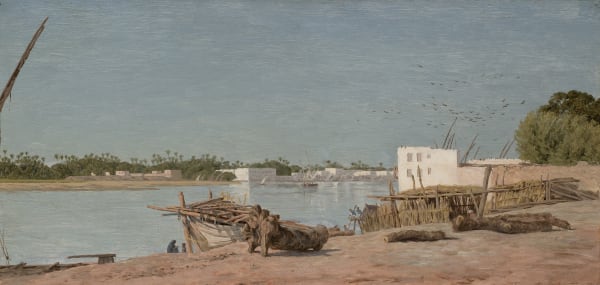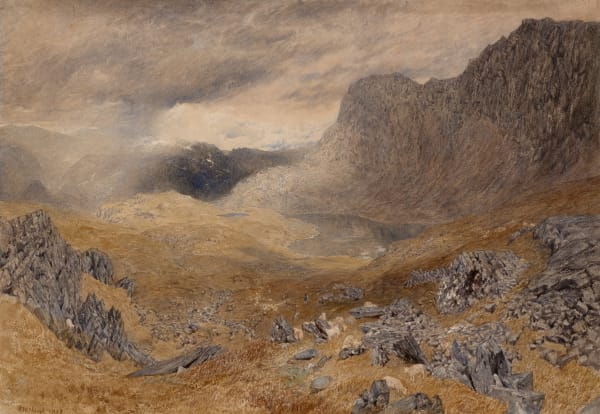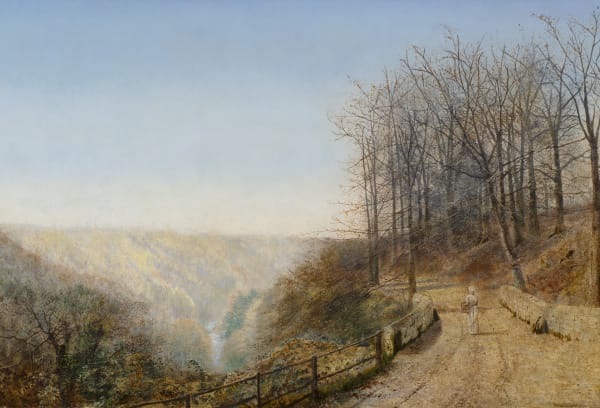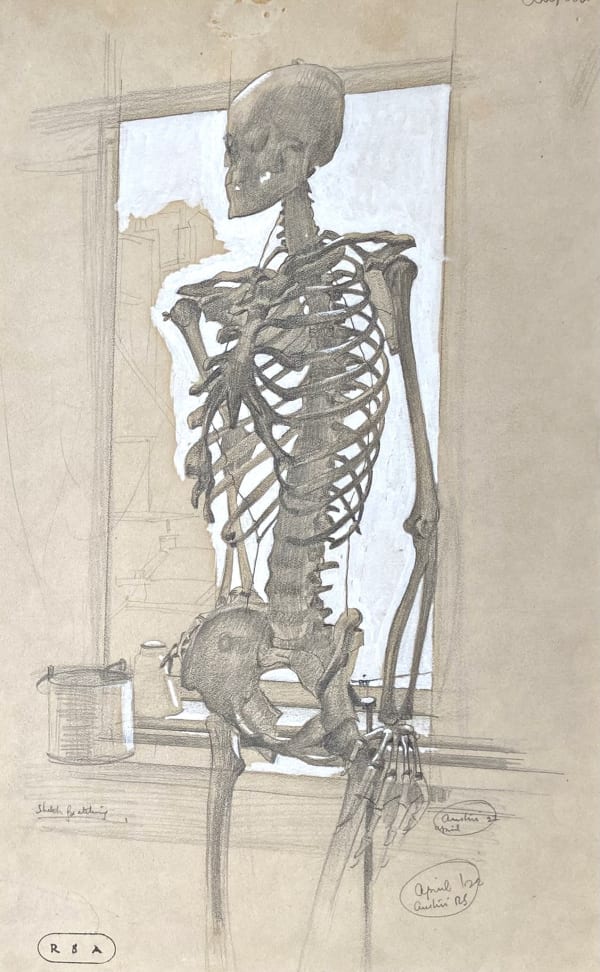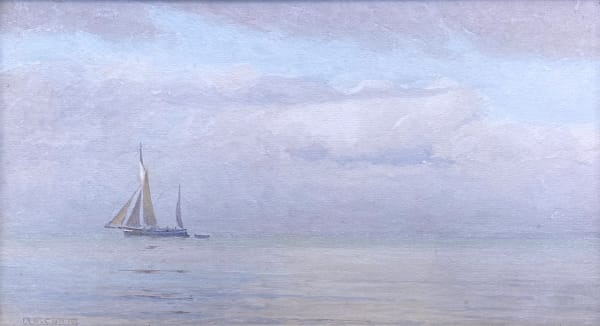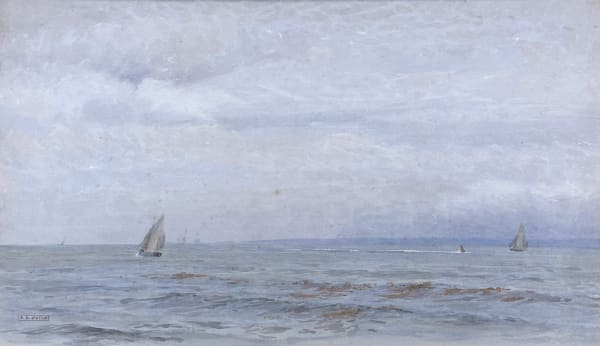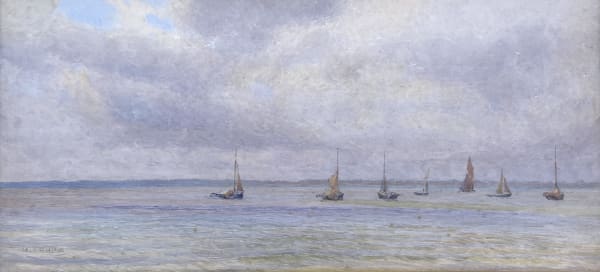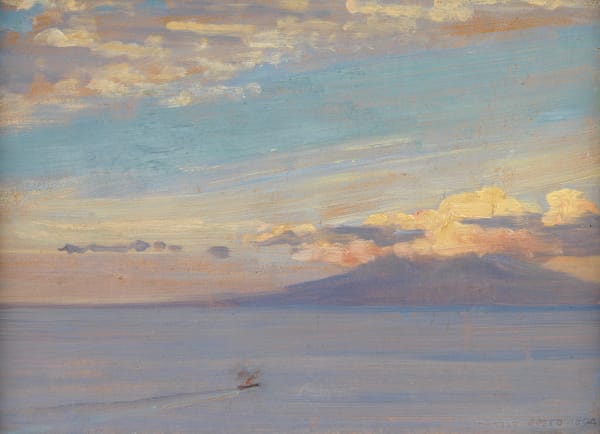-
 Henry Roderick Newman (1843-1917)Abu Simbel
Henry Roderick Newman (1843-1917)Abu Simbel -
 Anna Zinkeisen (1901-1976)Spring Flowers
Anna Zinkeisen (1901-1976)Spring Flowers -
 Ernest Albert Waterlow (1850-1919)'In his hand are the deep places of the Earth'
Ernest Albert Waterlow (1850-1919)'In his hand are the deep places of the Earth' -
 Harrington Mann (1864-1937)Italian Girl
Harrington Mann (1864-1937)Italian Girl -
 Sir Edward Coley Burne-Jones (1833-1898)A Design for Metal
Sir Edward Coley Burne-Jones (1833-1898)A Design for Metal -
 Alexander Stanhope Forbes (1857-1947)Mousehole Harbour, CornwallPOA
Alexander Stanhope Forbes (1857-1947)Mousehole Harbour, CornwallPOA -
 George Spencer Watson (1869-1934)A StudyPOA
George Spencer Watson (1869-1934)A StudyPOA -
 Arthur Ditchfield (1842-1888)A View of the Nile, near Cairo£6,800
Arthur Ditchfield (1842-1888)A View of the Nile, near Cairo£6,800 -
 Sir William Blake Richmond (1842-1921)A Wood near Volterra, Italy£6,400
Sir William Blake Richmond (1842-1921)A Wood near Volterra, Italy£6,400 -
 Henry Howard (1843-1934)After Rain, Locarno£8,500
Henry Howard (1843-1934)After Rain, Locarno£8,500 -
 Thomas Matthew Rooke (1842-1942)Carvings by The Cathedral Door Auxerre, France
Thomas Matthew Rooke (1842-1942)Carvings by The Cathedral Door Auxerre, France -
 Alfred William Hunt (1830-1896)Climbing Shadows
Alfred William Hunt (1830-1896)Climbing Shadows -
 Frank Lewis Emanuel (1865-1948)Downalong, St Ives£4,200
Frank Lewis Emanuel (1865-1948)Downalong, St Ives£4,200 -
 John Atkinson Grimshaw (1836-1893)Early Autumn on the Esk
John Atkinson Grimshaw (1836-1893)Early Autumn on the Esk -
 Harry van der Weyden (1868-1952)Evening on the Dunes£8,500
Harry van der Weyden (1868-1952)Evening on the Dunes£8,500 -
 By and Studio of Sir Edward Coley Burne-Jones (1833-1898)Figures on a balconyPOA
By and Studio of Sir Edward Coley Burne-Jones (1833-1898)Figures on a balconyPOA -
 Richard Buckner (1812-1883)Frederic Leighton, about 1860POA
Richard Buckner (1812-1883)Frederic Leighton, about 1860POA -
 Albert Ludovici, Jnr. (1852-1932)Harmony in Black
Albert Ludovici, Jnr. (1852-1932)Harmony in Black -
 Herbert William Palliser (1883-1963)Head of a Young Woman
Herbert William Palliser (1883-1963)Head of a Young Woman -
 Sir Gerald Kelly (1879-1972)LorettaPOA
Sir Gerald Kelly (1879-1972)LorettaPOA -
 John Brett (1831-1902)MacLeod's Maidens, Skye (natural sculpture)
John Brett (1831-1902)MacLeod's Maidens, Skye (natural sculpture) -
 Walter Greaves (1841 - 1930)Nocturne, Battersea Reach
Walter Greaves (1841 - 1930)Nocturne, Battersea Reach -
 Edward Reginald Frampton (1872-1923)Saint Cecilia
Edward Reginald Frampton (1872-1923)Saint Cecilia -
 Edward Reginald Frampton (1872-1923)Saint Cecilia
Edward Reginald Frampton (1872-1923)Saint Cecilia -
 Henry Moore (1831-1895)SeascapeSold
Henry Moore (1831-1895)SeascapeSold -
 John Samuel Raven (1829-1877)Sheep in a Storm
John Samuel Raven (1829-1877)Sheep in a Storm -
 Roy Hobdell (1911-1961)Still-Life: Iris, Narcissus, Tulips and Convolvulus, with MothsPOA
Roy Hobdell (1911-1961)Still-Life: Iris, Narcissus, Tulips and Convolvulus, with MothsPOA -
 John Pettie (1839-1893)Study of a Knight£9,500
John Pettie (1839-1893)Study of a Knight£9,500 -
 Joseph Arthur Palliser Severn (1842-1931)Sunset over Esthwaite Water
Joseph Arthur Palliser Severn (1842-1931)Sunset over Esthwaite Water -
 Andrew Law (1873-1967)The Black Cock
Andrew Law (1873-1967)The Black Cock -
 Edward Frederick Brewtnall (1846-1902)The Cloud's Turmoil, the Sun's Fierce Molten Fire
Edward Frederick Brewtnall (1846-1902)The Cloud's Turmoil, the Sun's Fierce Molten Fire -
 Frederick Weekes (1833-1920)The Haunted Glen, the Intruder£4,500
Frederick Weekes (1833-1920)The Haunted Glen, the Intruder£4,500 -
 Nora Lucy Mowbrary Cundell (1889-1948)The KitchenPOA
Nora Lucy Mowbrary Cundell (1889-1948)The KitchenPOA -
 Frank Cadogan Cowper (1877-1958)The Queen of Hearts She made some tarts, All on a summer’s dayPOA
Frank Cadogan Cowper (1877-1958)The Queen of Hearts She made some tarts, All on a summer’s dayPOA -
 Fred Uhlman (1901-1985)The Red Tower£8,500
Fred Uhlman (1901-1985)The Red Tower£8,500 -
 Robert Borlase Smart (1881-1947)Traghetto della Casson, VenicePOA
Robert Borlase Smart (1881-1947)Traghetto della Casson, VenicePOA -
 Christopher Wynne Nevinson (1889-1946)WandaPOA
Christopher Wynne Nevinson (1889-1946)WandaPOA -
 William Etty (1787-1849)Women Bathing£12,000
William Etty (1787-1849)Women Bathing£12,000 -
 Joseph Edward Southall (1861-1944)Gertrude Southall£12,000
Joseph Edward Southall (1861-1944)Gertrude Southall£12,000 -
 Robert Sargent Austin (1895-1973)Pensive Skeleton£3,500
Robert Sargent Austin (1895-1973)Pensive Skeleton£3,500 -
 Owen Baxter Morgan 1839-1917Ferry by Moonlight£1,800
Owen Baxter Morgan 1839-1917Ferry by Moonlight£1,800 -
 John Frederick Lewis (1804-1876)A Moorish Woman£6,500
John Frederick Lewis (1804-1876)A Moorish Woman£6,500 -
 Richard Rivington Holmes (1835-1911)Of My Lady in Death£6,500
Richard Rivington Holmes (1835-1911)Of My Lady in Death£6,500 -
 George Richmond (1809-1896)Head of a Sleepy Woman£3,500
George Richmond (1809-1896)Head of a Sleepy Woman£3,500 -
 Herbert Johnson Harvey (1884-1928)At the TablePOA
Herbert Johnson Harvey (1884-1928)At the TablePOA -
 William John Palmer-Jones (1887-1974)Dusk - The Colossi of Memnon£2,400
William John Palmer-Jones (1887-1974)Dusk - The Colossi of Memnon£2,400 -
 Marion Margaret Violet, Duchess of Rutland Manners 1856-1937Emmie Bourke£3,200
Marion Margaret Violet, Duchess of Rutland Manners 1856-1937Emmie Bourke£3,200 -
 19th Century BelgianInterior of Louvain Prison£4,800
19th Century BelgianInterior of Louvain Prison£4,800 -
 James Hall Nasmyth (1808-1890)A Marine Steam Engine of 220 Horses£4,800
James Hall Nasmyth (1808-1890)A Marine Steam Engine of 220 Horses£4,800 -
 Alma Claude Burlton Cull (1880-1931)A Still Morning£1,800
Alma Claude Burlton Cull (1880-1931)A Still Morning£1,800 -
 Alma Claude Burlton Cull (1880-1931)A Grey Day in the Solent£1,800
Alma Claude Burlton Cull (1880-1931)A Grey Day in the Solent£1,800 -
 Alma Claude Burlton Cull (1880-1931)Sailing Boats at Anchor£1,800
Alma Claude Burlton Cull (1880-1931)Sailing Boats at Anchor£1,800 -
 James Smetham (1821-1889)Study
James Smetham (1821-1889)Study -
 Donald Maxwell (1877-1936)Low Tide, Rochester Cathedral and Castle£1,800
Donald Maxwell (1877-1936)Low Tide, Rochester Cathedral and Castle£1,800 -
 John Colley Nixon (c. 1755-1818)Porte Saint-Denis, Paris 1815
John Colley Nixon (c. 1755-1818)Porte Saint-Denis, Paris 1815 -
 Violet Manners, Duchess of Rutland (1856-1937)Mrs Patrick Campbell£4,200
Violet Manners, Duchess of Rutland (1856-1937)Mrs Patrick Campbell£4,200 -
 Marion Margaret Violet, Duchess of Rutland Manners (1856-1937)Norah Bourke£3,200
Marion Margaret Violet, Duchess of Rutland Manners (1856-1937)Norah Bourke£3,200 -
 After Eugène Delacroix (1798-1863)Royal Tiger£3,600
After Eugène Delacroix (1798-1863)Royal Tiger£3,600 -
 Alfred Kingsley Lawrence (1893-1975)Sir William Rothenstein£1,600
Alfred Kingsley Lawrence (1893-1975)Sir William Rothenstein£1,600 -
 Attributed to Thomas Cooper Gotch (1854-1931)Study of a Boy£1,400
Attributed to Thomas Cooper Gotch (1854-1931)Study of a Boy£1,400 -
 Harold Speed (1872-1957)Vesuvius from Capri£6,500
Harold Speed (1872-1957)Vesuvius from Capri£6,500 -
 Herbert Dalziel (1853-1941)The New Suburb£3,500
Herbert Dalziel (1853-1941)The New Suburb£3,500 -
 George Washington Lambert (1873-1930)An Officer, 1918£2,500
George Washington Lambert (1873-1930)An Officer, 1918£2,500 -
 James Hayllar (1829-1920)A wandering minstrel in a quiet squarePOA
James Hayllar (1829-1920)A wandering minstrel in a quiet squarePOA -
 Walford Graham Robertson (1866-1948)Aurelius and Dorigen
Walford Graham Robertson (1866-1948)Aurelius and Dorigen -
 George Arthur Atkinson (1920-1988)Bomber's Nose, 1943£3,500
George Arthur Atkinson (1920-1988)Bomber's Nose, 1943£3,500 -
 Sir Edward Coley Burne-Jones (1833-1898)Euphrosyne Cassavetti
Sir Edward Coley Burne-Jones (1833-1898)Euphrosyne Cassavetti -
 19th Century BritishHead of a Girl£1,400
19th Century BritishHead of a Girl£1,400 -
 John Patrick (20th century British)Defence Spectre, 1949£2,800
John Patrick (20th century British)Defence Spectre, 1949£2,800 -
 Gerald Norden (1912-2000)John Ward in his studio at Bilting Court£2,500
Gerald Norden (1912-2000)John Ward in his studio at Bilting Court£2,500 -
 Freda Marston (1895-1949)The Maritime Alps, near Alassio£4,800
Freda Marston (1895-1949)The Maritime Alps, near Alassio£4,800 -
 Charles Sykes (1875-1950)The Rainbow, 1944£12,000
Charles Sykes (1875-1950)The Rainbow, 1944£12,000 -
 Jan Strube (1892-1985)Trespassing (De Overtreding)£4,800
Jan Strube (1892-1985)Trespassing (De Overtreding)£4,800 -
 Leonard Campbell Taylor (1874-1969)Venice£7,500
Leonard Campbell Taylor (1874-1969)Venice£7,500 -
 Edward Ridley (1883-1946)A Young Woman
Edward Ridley (1883-1946)A Young Woman -
 Harold Knight (1874-1961)A Cornish Boy, 1917POA
Harold Knight (1874-1961)A Cornish Boy, 1917POA -
 Anthony Augustus Frederick Sandys (1829-1904)Herbert H. RobertsPOA
Anthony Augustus Frederick Sandys (1829-1904)Herbert H. RobertsPOA -
 John Byam Liston Shaw (1872-1919)Mrs Paul Konody
John Byam Liston Shaw (1872-1919)Mrs Paul Konody -
 Edward Thompson Davis (1833-1867)My Mother, with a bottle of Gin£1,200
Edward Thompson Davis (1833-1867)My Mother, with a bottle of Gin£1,200 -
 Alfred Reginald Thomson (1894-1979)Phyllis the Flapper£9,500
Alfred Reginald Thomson (1894-1979)Phyllis the Flapper£9,500
Page
1
of 5







